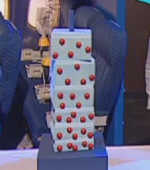Royal Institution Christmas Lectures 2007
Peak Performance
Rare Air
Dr Hugh Montgomery begins the first of this year's lectures with a group of audience volunteers in a mock-up of an airliner cruising at 29,500 feet. Simulating a window blow-out the volunteers need to don their oxygen masks as quickly as possible. Every breath at 29,500 feet has two-thirds less oxygen than it does at sea level. Dr Montgomery explains that unlike food, we can't store oxygen. We need a continuous supply of it. Without oxygen we lose consciousness within 90 seconds and can die within 5 minutes.
Why we need Oxygen
To demonstrate why we need oxygen, Dr Montgomery asks his young audience to stand, raise their arms and jump in the air shouting "Merry Christmas". While this appears frivolous, it demonstrates that they are doing mechanical work. Even sitting, your muscles are working to keep you upright, your heart is pumping blood round your body. All of this is work and all it takes energy.
Your body is also doing chemical work, its turning one molecule into another, it moving one molecule from one place to another. Its also doing electrical work, your brain is fizzing with electrical activity. All of this work needs energy. That energy comes from burning fuel and you burn that fuel with oxygen which is why you need it.

Compressed Air
Why then, do we have so much less oxygen at high altitudes? This is demonstrated using a simple frame to hold foam blocks representing air with red dots representing oxygen molecules. At the summit of Mount Everest, roughly two-thirds of the atmosphere is beneath you and all of that is weighing down on the molecules beneath. When the air is compressed, any given volume of air will contain more oxygen than the less compressed air found at higher altitudes. Lack of oxygen leads to lack of energy.
There must be some trick to it, because we hear of people who climb to the summit of Mount Everest.
We are introduced to Dr Sundeep Dhillon who has scaled Mount Everest twice. He claims that his body has adapted to cope with the thinner air.
While the lecture pauses for a break, Dr Montgomery poses the question:
How many cells are there in your body that burn oxygen?
- 100 million cells
- 100 billion cells
- 100 trillion cells
After the break he reveals:
- There are 100 million light-receiving cells at the back of your eye.
- Your brain alone contains 100 billion cells
- Your body contains 100 trillion cells, every one of which needs to burn oxygen
A Breath of Fresh Air
Air is drawn into the body through the nose and mouth. You may think of your airways as just simple pipes. They're actually very sophisticated and do a number of different things.
The first thing they do is filter the air. You have hairs in your nose that trap soot, pollen and other particles and stop them from getting to your lungs. All of the airways are lined with mucus to trap further particles. These are driven back by tiny hairs called cilia. They also warm and moisturise the air.
The lungs are composed of of fine, tiny tubes which end in small balloons, tiny air sacs There are 300 million of these in each lung. Its through these that oxygen reaches the bloodstream.

Alveoli
We are shown an electron microscope image of an alveoli or air sac in the lung. The walls of the alveoli are only 7 millionths of a millimetre thick, so the oxygen can diffuse very easily into the blood. A red blood cell contains something called haemoglobin which is what carries the oxygen Every molecule of haemoglobin can carry four oxygen molecules. There are 280 million haemoglobin molecules in every red blood cell and 5 billion red blood cells in every litre of blood.
One of the adaptations Sundeep's body has made for high altitude air, is to produce more red blood cells. Up to 60% of Sundeep's blood is made up of red blood cells, where the normal person is nearer 40%
Your heart is effectively four pumps and between each of these pumps are valves to make sure the blood flows in one direction only. As these valves close they make the noise we know as our heartbeat. The heart is solid muscle and is the most extraordinary endurance machine. Sitting at rest its beating sixty time a minute and pumps over 7,000 litres of blood a day.
The heart is a pump and as such it produces intermittent flow. However, the body cells need a continuous supply of oxygen. The aorta is a flexible pipe that stores energy with every pulse and the subsequent narrow blood vessels provide resistance smoothing the flow.
We take another break and are set the following question:
What is the length of the small blood vessels in your body?
- 93 kilometres
- 93 hundred kilometres
- 93 thousand kilometres
The answer is a startling 93 thousand kilometres.
One of the other adaptations Sundeep's body makes for high altitudes is to sprout even more small blood vessels.

Mitochondria
The blood is sent around the whole body to a mass of small capillaries, but what is the oxygen for? This is down to a very interesting piece of biology. Around 1.5 million years ago, our cellular ancestors picked up a germ, a bacterium really. That bacterium was a very strange creature becuase it could burn oxygen to make fuel. That germ is still in our bodies now, in every single one of our cells. They're called mitochondria. Inside is a membrane and we are shown a model of this.
When we eat food it undergoes a number of chemical reactions, the net result of which is that we push hydrogen atoms through this membrane. The oxygen in out blood reacts with the hydrogen to produce water and energy. This energy is known as ATP.

